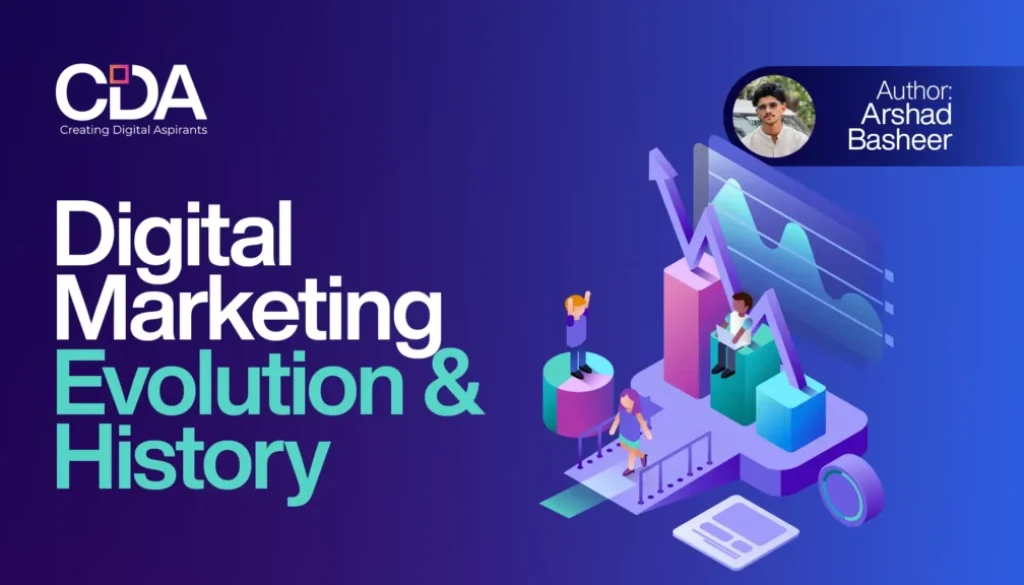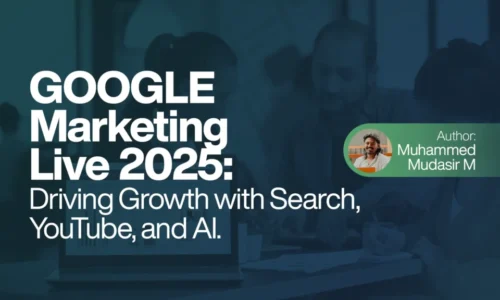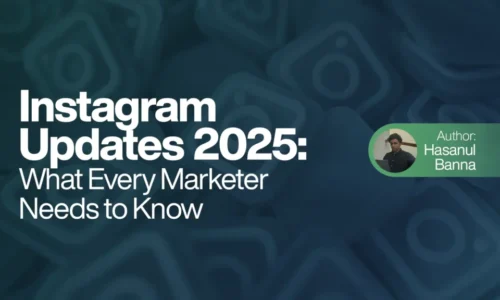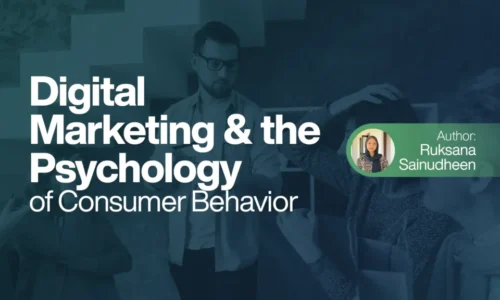Digital Marketing Evolution and History
Every working professional is expected to know at least the fundamentals of digital marketing in a world where over 170 million individuals regularly use social media. To put it simply, digital marketing is the process of promoting things online or through other electronic media. “Digital marketing” is defined by the Digital Marketing Institute as “the use of digital channels to promote or market products and services to targeted consumers and businesses.”
Table of Contents

What is Digital Marketing?
Digital marketing is the use of any digital platform by an organisation to advertise or promote goods and services to customers. Digital marketing makes use of many websites, mobile devices, social media, search engines, and related platforms.
The Advantages of Digital Marketing
In less time, you can reach a bigger audience. With advances in technology, traditional marketing departments and agencies have seen an important decrease in customers. Digital marketers have made the most progress in places where people are now using computers, tablets, and phones.
What is the Level of Success for Digital Marketing?
The number of shoppers in the marketplaces has been noticed to gradually decline with the introduction of digitalisation, and an increasing number of people are now observed to purchase online for themselves and their family. Because you want to reach the ideal audience, and that audience is online, there are a lot of benefits to advertising your business online.
History of Digital Marketing
As we are discussing about digital marketing evolution and history, The 1990s saw the introduction of the phrase “digital marketing.” With the introduction of the internet and the creation of the Web 1.0 platform, the digital age really took off. Although users could locate the information they needed, sharing that information online was not possible with the Web 1.0 platform. Global marketers were still unaware of the internet platform till then. The internet had not yet been widely adopted, so they were unsure if their plans would be effective.
The first clickable banner went up in 1993, and HotWired bought a couple of them to use in their advertising. This signalled the start of the shift in marketing towards the digital age. 1994 saw the introduction of new technologies into the digital marketplace as a result of this steady change. In the same year that Yahoo debuted.
Regarded as “Jerry’s Guide to the World Wide Web” in honour of its creator, Jerry Yang, Yahoo garnered around one million hits in its inaugural year of operation. As a result, the digital marketing industry saw drastic shifts, with businesses optimising their websites to rank better in search results. A few other search engines and tools, including LookSmart, HotBot, and Alexa, were introduced in 1996.
Google launched in 1998. Microsoft introduced the MSN search engine, and Yahoo introduced Yahoo web search to the public. When the internet bubble burst two years later, all of the smaller search engines were either left behind or completely destroyed, making room for the industry titans. The first significant upswing in the field of digital marketing occurred in 2006 when search engine traffic was estimated to have increased to over 6.4 billion in a single month. Microsoft, not one to be left behind, shelved MSN and introduced Live Search to take on Google and Yahoo.
Social networking sites quickly started to appear. The first social networking site to appear was MySpace, and Facebook followed shortly after. Numerous businesses came to the realisation that the plethora of new websites was creating chances for them to market their brands and products. It marked the start of a new chapter in company history and opened up new business opportunities. They required innovative strategies to market their brands and take use of the social media website now that they had more resources.
Another significant turning point in the history of digital marketing was the cookie. Marketers started searching for alternative strategies to profit from the nascent technology. One such method involved monitoring the typical online surfing behaviours and usage patterns of regular internet users in order to customise marketing materials and promotions to their preferences. The original cookie was created to keep track of user behaviours. Over time, the purpose of cookies has evolved, and they are now designed to give marketers more options for gathering actual user data.
Digitally advertised products are now always available to consumers. According to data gathered by Marketing Tech Blog in 2014, social media posting ranked as the most popular online activity in the United States. The typical American uses social media for 37 minutes per day. 97% of digital marketers use Twitter, 69% use Pinterest, 59% use Instagram, and 99% use Facebook for marketing purposes. Facebook has been the source of consumers for 70% of B2C marketers. Twitter followers are considerably more inclined to make purchases from brands, according to 67% of Twitter users. Luxury companies are represented on Pinterest by 83.8% of them. The three most popular social media platforms utilised by marketers are Facebook, Twitter, and LinkedIn.

Who Launched Digital Marketing at First?
Digital marketing first appeared in India in 1995 when CSNL began offering internet services. In the beginning, it did not perform well because, by 2020, only 0.5% of people were online.
The Millennial Generation
A huge financial bubble burst in the year 2000. But many businesses suffered during the bubble’s height and fall between 2000 and 2002. As the economy recovered from the boom, a number of new websites were introduced in the 2000s. These included the debuts of Facebook in 2004, Myspace and WordPress in 2003, LinkedIn in 2002, and LinkedIn in 2004. Mobile text message marketing gained popularity in the early 2000s.
The Era of Mobile Technology
Increased marketing and sales were observed in the second half of the decade, with Amazon’s e-commerce revenues topping $10 billion. As Whatsapp, Instagram, and Snapchat entered the digital sphere during the ensuing years, mobile app culture grew.
The Present
A person uses a mobile device for digital media consumption 65 percent of the time they spend online. With Google Ad Words providing 96% of the company’s revenue, the digital advertising market is currently estimated to be worth $200 billion. Social networking has spearheaded the change in digital marketing, with an estimated 3.1 billion users globally. The $1 billion influencer market is expected to continue growing as a result of the popularity of bloggers and Instagram. With several new innovations and improvements in this fascinating sector, digital marketing is predicted to rise in the upcoming years.
In 2024, Become a Digital Marketer
The internet marketplace is always changing. Professionals in digital marketing need to figure out how to stay ahead of this shift. They must possess the ability to notice new trends and the creation of more sophisticated search engine algorithms. Nobody can afford to fall behind in this race, after all.
For comprehensive information on the history, development, and newest trends of digital marketing, as well as to acquire the skills of the future, check out our postgraduate program in the field.
Conclusion
In the Internet age, digital marketing has changed the commercial world. The evolution of digital marketing is evidence of how the internet has transformed marketing. From its humble beginnings, digital marketing has evolved to become essential to modern business tactics.
Author Info
Arshad Basheer, a Digital marketer in Kannur
Learner Of CDA Digital Marketing Course in Kerala



